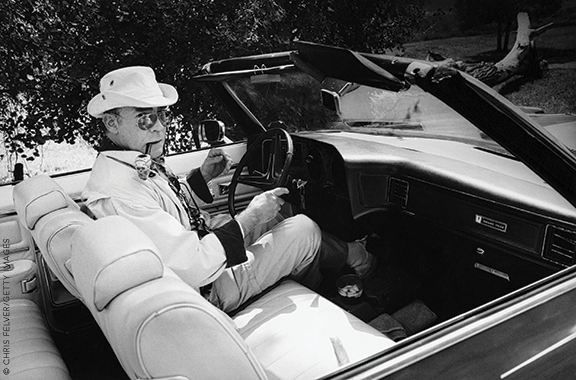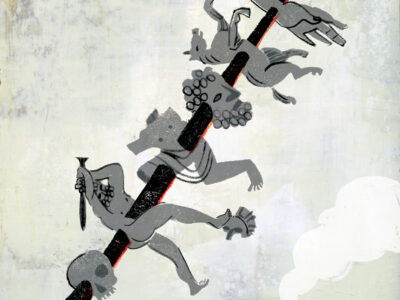
A legendary substance-abusing writer needed an assistant, and a young
alumna answered the call. Somehow, she survived to tell the tale.
Say you’re 22 years old, less than a year out of Penn, with a couple of magazine internships and bartending stints under your belt and not much else. You get a tip that a legendary writer—one as famous for his broad-spectrum drug intake as for his literary output—is looking for an assistant, preferably young and female. So you fire off an application letter, get a 3 a.m. phone call from the legend himself, and the next day you’re flying off to his compound in the Colorado Rockies, where breakfast is usually Scotch, dinner may cause hallucinations, and fun frequently involves guns—all manner of guns, fired under the influence of breakfast and/or dinner.
It doesn’t take you long to realize that you’re not in Connecticut anymore. But you somehow survive the weekend tryout, go home—and come back for what is likely to be the most intense five months of your life.
In the novel you write 20-some years later—Gonzo Girl, published this past July by Touchstone/Simon & Schuster—you will change the name of your narrating central character from Cheryl Della Pietra C’91 to Alley Russo. You’ll change the name of the legendary writer: from Hunter S. Thompson to Walker Reade. But you’ll make it clear to the world that, while you’ve altered a number of details—some at the insistence of your publisher’s lawyer—more than half of the material in this work of fiction is based on reality. Assuming such a word can be used for that scene.
Not that anybody is challenging your account. After all, this is Hunter Thompson we’re talking about—inventor of Gonzo journalism and author of such twisted classics as Fear and Loathing in Las Vegas, Fear and Loathing: On the Campaign Trail ’72, and Hell’s Angels. Not to mention the inspiration for the maniacal Doonesbury character named Duke—which he hated, but that’s another story.
Consider this taste from Gonzo Girl, based on a series of events that took place on Della Pietra’s third day on the job:
Once we’re in the car, he takes a small plastic bag out of his pocket and starts jamming whatever’s in it into the chocolate cake. He hands me a plastic fork. “Have a bite.”
“What is it?”
“Just eat it.”
“Jesus, Walker. At least tell me what it is.” He puts a forkful in front of me, and I see gnarly, dried globs in the cake. Mushrooms.
“You don’t trust me?” This question seems a little beside the point. Of course I trust that these are proper hallucinogenic mushrooms. The real question is if I want to do them. A few days prior I’d had something of an epiphany: I would treat my time out here like AA, but in reverse. Instead of adopting a “one day at a time” approach for not abusing substances, I was going to take that approach for abusing them. I grab the fork and chew slowly. Even buried in the chocolate the mushrooms have the consistency and smell of dried manure. Walker takes a couple of bites of his cake and starts up the Caprice. I notice the backseat has a blanket covering up something.
“Where are we going?”
“To have some fun …”
That starts when they drive up a mountain road and see some tourists.
They instantly recognize Walker, and several of them start clapping and yelling and taking pictures. Walker stops the Caprice and I can feel the drugs starting to kick in a little. They’re my first-ever mushrooms, and the early reviews are good. It feels like the acid minus the edge—I’m just happy in a simple, uncomplicated way. We are both smiling widely, and when Walker reaches into the backseat, grabbing from beneath the blanket what appears to be not the Taser, but a small handgun, I’m so blindly happy that I don’t even pause to consider that someone might die. …
The gun makes an awful screeching sound, and Walker and I fall back into the car as he guns the engine, launching us first in a big circle … and then down the hill. It occurs to me in a shroom-induced laughing fit that I am now a character in a Walker Reade novel. I am The Girl in the Car. It feels like we are on a great big roller coaster that only knows how to go downhill … fast.
That’s when they see the flashing police lights behind them. Fortunately for them, the local cops are used to the local legend, and after a pro forma warning, the hallucinating duo are soon shooting at exploding targets with a .44 Magnum.
All of which prompts our intrepid young heroine to think to herself: “Huh—this must be just a day at the office, right?”
“Yeah, it was thrilling sometimes, just really thrilling,” Della Pietra is saying. “And it was very difficult to not feel like you were in a movie half the time.”
We’re sitting at an outdoor table of Nellie Green’s, a restaurant in her current hometown of Branford, Connecticut, looking out at the Branford River on a warm September afternoon. Her eyes glitter as the memories roll out. Her dark hair, flecked with silver, is much shorter than it is in her publicity photo, thanks to recent rounds of chemotherapy. Last fall, right around the time the galleys of Gonzo Girl arrived, Della Pietra found out she had lymphoma.
“It was a very weird year,” she says. “I guess if you’re going to get cancer, it was the kind you want—eminently treatable, and I got a clean bill of health in April.” But still—“having your lifelong dream and your worst nightmare coming true in the same year is really confusing.”
It’s fair to say that her life is a little different these days. She’s married now, the mother of a nine-year-old boy. (He’s not allowed to read Gonzo Girl until he’s 40, though she does show a photo of him wearing one of Thompson’s Tilley hats, which she had inadvertently swiped on the way to the Denver airport her last day on the job.)
Her son was a toddler, sleeping in the back seat of her car at Jacob’s Beach in nearby Guilford, when Della Pietra first began bringing those five seriously crazy months alive in her small moleskin notebook. She started with the time Thompson asked her to pick up a quantity of cocaine.
“That was the first scene I wrote,” she says. “I was like, ‘That came pretty easy. Might have something here.’ And then I just sort of kept going from that.”
It took her about five years to complete the manuscript.
“For me it’s always just finding the time and solitude,” she says. “I mean, I’m a mother to a young, rambunctious boy. My husband’s really good; I’m able to go away, like, one weekend a month and just write.”
Several factors prompted her to write up the experience as a novel rather than a nonfiction memoir. (She had already written a short nonfiction piece for P.O.V. magazine in 1998, the year the film version of Fear and Loathing in Las Vegas came out, with Johnny Depp playing Thompson and Benicio del Toro playing Dr. Gonzo. Thompson called her family’s house at 3 a.m. to tell her that he really liked the article, but she wasn’t home, so he had to tell her groggy father.)
“One was remove,” she says. “I mean, it was 23 years from the experience, which was not particularly linear. A memoir has to have that narrative quality to it—you have to have the structure.” Furthermore, “I wanted to give myself the freedom to kind of say what I wanted to say about the experience, rather than be beholden to this ‘100 percent true’ accounting of events, which I didn’t think would be particularly interesting.”
Then there was the literary aspiration of a former English major. “I always fancied myself a novelist, or somebody who wanted to write a novel. And this was just great material.”
Thompson was working on a never-published novel titled “Polo Is My Life” during Della Pietra’s time at Woody Creek. By then he was in the twilight of his career, but “even with everything he was on and everything we were doing,” she says, “he could still really tear up a sentence.”
She cheerfully admits exaggerating how much her Gonzo Girl character was rewriting the legend’s prose behind his back, and how much she feared his wrath if he found out. “That was just to up the stakes in the book a little bit,” she says. “Maybe some of it was wishful thinking.”
Her main job in both the book and reality was to get him to the typewriter by 2 a.m. (that is not a typo). It was a task that required considerable creativity and cajoling—and often sparked unpleasantly acerbic outbursts. She survived in part because she had a fairly thick skin for verbal abuse and his almost comically sexist attitudes.
“I guess I’m not offended by that,” she says. “I do think he had these very old-school ideas of women’s role. He looked at the women in his life to nurture. He had a [full-time] assistant; he had a girlfriend; he had me. In the book I call it the ‘care and feeding of the modern American icon.’”
The stereotyping extended to his work, she suggests. “The female character is never fully fleshed out. They’re just sort of generally trouble—you know, leading you down through the primrose path.” (We didn’t ask about the veracity of the tenderly hot little sex scene between Alley and Walker, which involved the liberal use of … garlic, though in her P.O.V. article Della Pietra indicates that her relationship with Thompson never went beyond a single “fumbled kiss.” As for her character’s romantic dalliance with a visiting film star, No comment.)
Whether or not Della Pietra’s deft hand with a Bloody Mary counts as “nurturing” is debatable, but it probably helped her get the job and was clearly appreciated by her boss. (She learned her craft at the late Bocce Pizza in West Philly and refined it at Terra Blues in the West Village.) After Walker snaps at her in Gonzo Girl for not anticipating his needs, Alley starts mixing a pitcher of margaritas, which earns her a compliment and helps take the edge off the cocaine—all of which is consumed after they’ve come home from a $1,500 dinner at a local restaurant fueled by top-shelf LSD, shots of Wild Turkey, a bottle of Lafite Rothschild, and enough food “for a UN food drop—if UN food drops were delivered to acid-trippers with little or no appetite.”
“As you can imagine, it was just a very intense experience on every single level,” Della Pietra says. “Physically, staying up all night, the drug use, the alcohol. That’s one thing that’s not embellished in the book. And the moodiness was crazy. I mean, the fights he used to get into—it was too much for me.”
Considering that he once threw a plate at her head—he missed, but in the book Walker hits Alley with a Grammy statue—it may come as a surprise that, for all the jangled nerves, she never felt threatened. And her one hope is that her admiration and fondness for him comes through.
“It’s very hard to describe how safe I felt,” she says. “One of Hunter’s former assistants called me recently. She said, ‘You nailed it. You really nailed that day-to-day. It’s so hard to describe what a sweetheart he was’—even despite the raging and the substances, which God only knows how much contributed to that mood.”
When she finally left, she says, they parted on “really good terms.” She even agreed to outline another book for him, which he never wrote, but which would have told the story of his 1990 sexual-assault charges—which, she notes, were dismissed, “but not without a lot of Sturm und Drang.”
The last time she saw Thompson was on Halloween night, 1998. He was in New York, doing a reading for The Rum Diary at the Union Square Barnes & Noble. At the urging of her boyfriend—now husband—they braved the Halloween night insanity, and Della Pietra waited in line with a copy of Thompson’s book like everybody else. Finally she got to the front of the line.
“He looks up at me, grabs me, pulls me across the table, and starts giving me a noogie in front of hundreds of people,” she says, laughing delightedly. “And he goes, ‘Stay over there—you’re coming out with us.’ We ended up going to Gramercy Tavern with his entourage,” which included his girlfriend Anita (later his wife), and Benicio del Toro. It was, says Della Pietra, a “very sweet moment.”
Gonzo Girl ends with what feels like a postscript: Alley, back in New York just after 9/11, hears of Walker Reade’s suicide and thinks back to the time he taught her to shoot the .44 Magnum. Thompson, in fact, killed himself in 2005, using one of his many handguns to do the job. His ashes were blasted out of a cannon at the Woody Creek compound.
But Della Pietra still has his hat.
“I’ve had it for the past 23 years, and I’ve moved a million times,” she says. “Now I bring it to the readings, and people are always, like, ‘Can I touch the hat?’ Not to get all goopy about it, but you feel like he’s there. It’s just very special.” —S.H.




